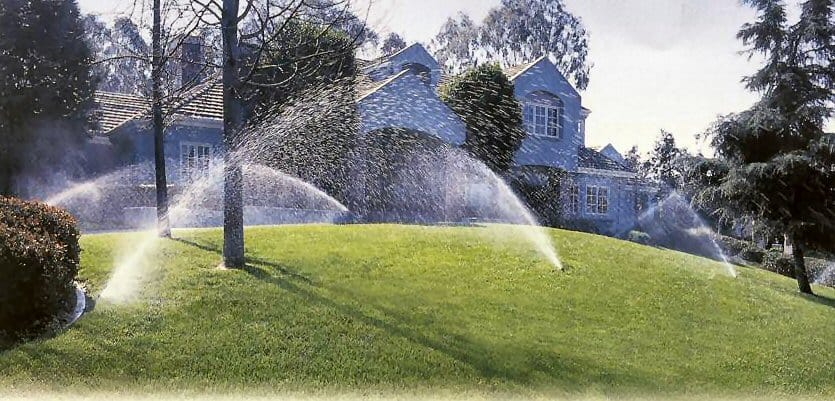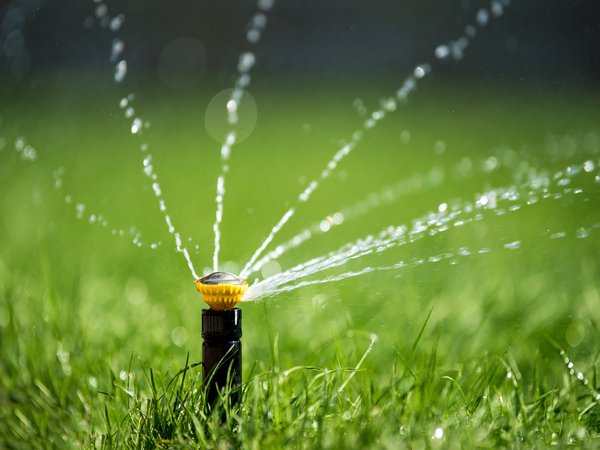Checking out the Most Common Problems in Lawn Sprinkler Systems and Their Repairs
Lawn sprinkler are essential for preserving healthy and balanced landscapes, yet they frequently encounter different problems. Usual concerns include clogged up nozzles, busted pipes, and unequal watering patterns. Each of these can markedly affect system efficiency and water performance. Comprehending these problems and their remedies is essential for any kind of property proprietor. The following areas will outline normal obstacles and the necessary repair work to maintain a lawn sprinkler system operating at its best. What comes next may shock those unprepared for maintenance realities.
Clogged Nozzles and Sprinkler Heads
Clogged up nozzles and lawn sprinkler heads are common problems that can significantly impede the efficiency of a lawn sprinkler. In time, debris such as mineral, dust, and algae buildup can gather, blocking water circulation and leading to unequal coverage in the lawn or yard. This can lead to specific locations receiving inadequate water, while others may come to be over-saturated.
Routine maintenance is essential to stop these blockages. Routine checks can identify any obstructions, and cleansing can frequently be achieved with basic tools like a little brush or a toothpick. In some instances, soaking clogged up components in vinegar can aid dissolve natural resource.
For serious clogs, substitute of the nozzle or head might be essential to bring back proper function. Attending to these problems without delay guarantees that the automatic sprinkler operates successfully, enhancing and keeping a healthy and balanced landscape water use.
Broken Pipes and Leaks
Damaged pipelines and leakages can significantly disrupt the performance of a lawn sprinkler system. Determining pipeline damages early is important to stop additional difficulties, and comprehending repair service techniques can improve the process. In addition, implementing preventative maintenance pointers can aid assure the longevity of the system and decrease the probability of future problems.
Identifying Pipeline Damages
Exactly how can property owners properly recognize pipeline damages in their lawn sprinkler systems? To start, they should consistently evaluate their backyards for uncommon damp areas or merging water, which may indicate a leakage. Additionally, home owners can check their water expenses for inexplicable increases, suggesting hidden leaks within the system. Observing the sprinkler heads for uneven spray patterns or insufficient insurance coverage can also signal prospective pipeline problems. Listening for unusual sounds, such as gurgling or hissing, may indicate air escaping from harmed pipes. Carrying out visual assessments of exposed pipelines for fractures or deterioration can aid pinpoint troubles. By using these approaches, property owners can proactively address and identify pipeline damages in their lawn sprinkler prior to it results in much more significant problems.
Repair Techniques Introduction
Attending to pipe damages in a sprinkler system requires an organized technique to repair work, specifically when handling breaks and leaks. The initial step often entails finding the broken area, which can be accomplished with visual assessment or pressure testing. Once identified, the repair work method might differ; for little leakages, utilizing pipeline sealant or epoxy can properly secure the damaged section. In cases of significant breaks, cutting out the harmed pipe section and changing it with brand-new piping, secured with proper ports, is recommended. In addition, ensuring proper positioning and safeguarding joints will certainly help prevent future concerns. After repair work, comprehensive testing of the system is necessary to confirm that leakages have actually been solved and that the system runs effectively.
Preventative Maintenance Tips
To reduce the threat of broken pipes and leakages in a lawn sprinkler system, normal preventative maintenance is essential. Property owners ought to consistently inspect the system for noticeable damage, making sure that pipes and installations are intact. Seasonal adjustments are important; before winter season, systems need to be drained to stop cold, while springtime checks can identify wear from frost or moving soil. Furthermore, keeping the location around sprinkler heads free from debris assists avoid clogs that can cause leaks. Regularly testing water stress can disclose underlying problems, as extreme pressure might stress pipes. Lastly, documenting upkeep tasks can help track performance and identify reoccuring issues, making it less complicated to deal with any kind of issues proactively.
Irregular Watering Patterns
Unequal watering patterns can result in stressed plants and uneven grass, coming from various causes such as stopped up nozzles or misaligned lawn sprinkler heads. Determining these problems is vital for efficient repair work and making sure consistent water distribution throughout the landscape. Solutions might involve straightforward maintenance tasks or changes to the sprinkler system for perfect efficiency.
Sources Of Irregular Watering
When a lawn sprinkler system stops working to distribute water equally throughout a yard, numerous factors may add to this problem. One usual reason is inappropriate lawn sprinkler head positioning, which can bring about overlapping or inadequate protection. Furthermore, stopped up nozzles can limit water flow, causing completely dry patches. Variants in water stress can additionally affect circulation, as some locations might receive much more water than others. Additionally, uneven terrain or dirt compaction can affect just how water passes through the ground, bring about irregular absorption. The age of the lawn sprinkler elements might result in lessened performance, contributing to irregular watering patterns. Identifying these reasons is website important for preserving a reliable automatic sprinkler and making sure a healthy grass.
Solutions for Repairing Issues
Resolving unequal watering patterns needs a methodical method to recognize and correct underlying issues. First, examining lawn sprinkler heads for obstructions or damage is essential; cleansing or changing them can improve water distribution. Next off, adjusting the automatic sprinkler's pressure settings may assist achieve an extra uniform spray. In addition, assessing the layout of the lawn sprinklers can reveal locations that need rearranging to guarantee insurance coverage consistency. Looking for leakages in fittings or pipelines is vital, as leakages can lead to unequal watering. Ultimately, programming the timer to suit various zones based on plant needs can enhance overall efficiency. By carrying out these services, one can efficiently bring back well balanced watering patterns within the landscape.
Timer and Control Concerns
A well-functioning timer is critical for peak sprinkler system efficiency, many homeowners encounter concerns that interrupt their watering timetables. Common problems consist of faulty shows, where timers might not reflect the designated watering times, causing over- or under-watering. In addition, power failures can reset timers, triggering them to revert to skip settings and overlooking the customized schedules house owners rely on. Breakdowns can likewise stem from out-of-date innovation; older timers might do not have the features needed for optimum control, such as rain sensing units or wise technology combination. Electrical wiring issues can protect against signals from reaching the shutoffs, providing the system inoperable. Routine upkeep and prompt updates can assist minimize these concerns. Home owners ought to think about seeking advice from professionals for repairing to guarantee their timers run effectively and successfully, as appropriate control is essential for keeping a healthy and balanced landscape and conserving water resources
Sprinkler System Stress Problems
Exactly how can inadequate water stress impact an automatic sprinkler's efficiency? Not enough water stress can result in uneven water distribution, leading to dry patches and overwatered locations. This variance compromises the total wellness of the landscape, as plants may struggle with either dry spell tension or origin rot. Reduced pressure can likewise impede the operation of sprinkler heads, stopping them from reaching their designated variety and protection.
 Conversely, excessive stress can cause damage to the system, causing leaks or busted elements. Burst pipes and malfunctioning lawn sprinkler heads might occur, sustaining pricey repair services. Determining the source of stress concerns is vital; usual offenders consist of stopped up filters, malfunctioning shutoffs, or perhaps community supply issues. Normal system checks can aid maintain appropriate stress, ensuring a reliable and reliable lawn sprinkler. Correct pressure management is essential for peak performance and durability of the irrigation system.
Conversely, excessive stress can cause damage to the system, causing leaks or busted elements. Burst pipes and malfunctioning lawn sprinkler heads might occur, sustaining pricey repair services. Determining the source of stress concerns is vital; usual offenders consist of stopped up filters, malfunctioning shutoffs, or perhaps community supply issues. Normal system checks can aid maintain appropriate stress, ensuring a reliable and reliable lawn sprinkler. Correct pressure management is essential for peak performance and durability of the irrigation system.Seasonal Maintenance Tips
As the seasons modification, implementing routine maintenance for an automatic sprinkler comes to be important to assure peak performance and durability. Home owners must start by examining the system prior to the onset of each season. In the spring, evaluate for any wintertime damages, tidy the nozzles, and adjust the spray patterns to suit new development. Throughout the summer, verify that all areas are running effectively, keeping an eye on for any type of dry spots or overwatering. In the fall, it is necessary to prepare the system for winter season by draining the lines, blowing out the pipelines, and insulating any kind of exposed elements. Finally, a detailed inspection in the wintertime can aid identify possible problems that might arise in the springtime. Normal maintenance not just lengthens the life of the automatic sprinkler yet also promotes a healthy and balanced landscape, minimizing water waste and ensuring an effective watering process throughout the year.

Fixing Usual Lawn Sprinkler Issues
What actions should homeowners take when confronted with common lawn sprinkler issues? Initially, they need to observe the system for visible signs of malfunction, such as wet spots or damaged heads, indicating leaks. Next off, checking the timer setups and confirming the system is set properly is crucial, as incorrectly established timers can bring about overwatering or underwatering. Property owners need to likewise examine the valves for obstructions and confirm they open and close properly.
If the system shows low water stress, it might result from a clogged up filter or a malfunctioning pump, demanding extensive cleaning. Furthermore, homeowners should validate that the irrigation areas are working separately and not overlapping, which can waste water. If problems linger, speaking with a specialist might be essential to diagnose and resolve more complicated problems, confirming the lawn sprinkler runs efficiently and effectively.
Often Asked Inquiries
Exactly how Frequently Should I Check My Lawn Sprinkler System?
A lawn sprinkler must be checked at the very least twice a year, preferably in springtime and loss. Normal checks assist determine leaks, obstructions, and various other issues, ensuring optimal efficiency and water effectiveness throughout the seasons.
Can I Mount an Automatic Sprinkler Myself?
Yes, an individual can install an automatic sprinkler themselves, offered they have the required tools, understanding, and skills. It is suggested to speak with local regulations and standards to assure proper installation and conformity.
What Is the Average Lifespan of a Lawn Sprinkler?
The typical lifespan of a lawn sprinkler normally varies from 10 to twenty years, depending upon the high quality of materials, upkeep techniques, and ecological problems, which can considerably impact its durability and general performance. lawn sprinkler repair.
Are There Eco-Friendly Options for Lawn Sprinkler Solutions?
Environmentally friendly options for automatic sprinkler consist of drip irrigation, rainfall sensing units, and smart controllers. These technologies save water, decrease overflow, and promote effective watering, making them sustainable choices for ecologically mindful home owners seeking efficient watering options.
How Do Weather Impact Lawn Sprinkler Performance?
Weather significantly influence sprinkler performance; as an example, too much warm can result in evaporation, while heavy rains might create oversaturation. Additionally, wind can interrupt water distribution, causing inefficient watering and uneven protection throughout landscapes.
Stopped up nozzles and sprinkler heads are common concerns that can considerably prevent the performance of a sprinkler system. When a sprinkler system stops working to distribute water equally across a yard, a number of aspects might contribute to this issue. A well-functioning timer is vital for peak sprinkler system efficiency, many property owners run into issues that disrupt their irrigation schedules. How can inadequate water stress influence a sprinkler system's performance? Normal system checks can aid preserve appropriate stress, making sure a reliable and efficient lawn sprinkler system.